“VPK” observer infiltrated the “Dar’yal” Training Center of Scout Detachments.
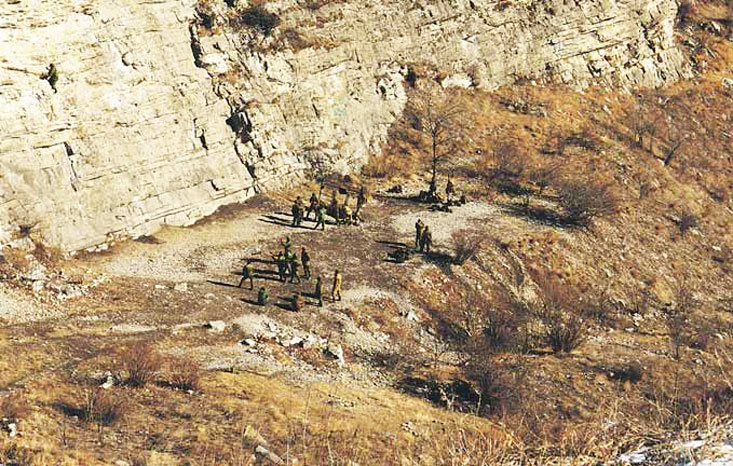
Originally appeared at VPK, translated by Comrade Korolyov exclusively for SouthFront; Edited by Yoana
“We do not train sportsmen or mounaineers. We train scout troops, who are able to perform their mission in alpine areas,” says the commander of 54th training center of Southern military district, major Konstantin Plotnikov.
The “Da’yal” center is located in the Sunny Valley (Solnechnaya Dolina), near Vladikavkaz. It became operational 13 years ago – on August 1, 2003. As Chechen combat showed, at that time the army scouts were very limited in their alpine skills.
When the shot means you ‘’screwed up’’
“Currently, we train scout companies from scout battalions of army brigades. In other words, we train them to complete the same tasks as they would on the plains, but with the difference that it is in the mountains”, – major Plotnikov says.
According to the instructors and teachers in the center, the main task of the scout detachment is not to cause a diversion, mine areas, but rather to sneak into a particular area, locate the enemy, report the gained information, and give coordinates for a strike, all while being invisible, continuing their mission. One of the main commandments of Russian scouts: “If you fired a shot, you screwed up”.
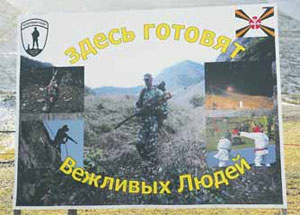
“Theoretically, after completing the course our graduates are ready to work on height up to 2500-3000 meters. But the truth is that they are ready to work as high as they can climb to. The main task is to teach them to operate in an environment, where heights constantly change. They must always be ready for the enemy to descend onto them from above, but also to be higher than the enemy. Another important part of the training is to teach the soldiers to get through very difficult terrain. Vertical cliffs, mountains of various steepness, mountain streams, etc. All this is done only as being part of a team”.
The course is designed to last 2 months, at the same time 5 companies can train in the center. Among with the theoretical part, the troops, arriving in Dar’yal, are required to have practical skills in working on a plain. In the center everyone is required to go through a number of examinations, including a PT test.
“As part of an entry examination, our task is to not highlight individual troops, it’s to objectively grade the performance of a section as a whole”, – says Konstantin Plotnikov.
The training programme in the center starts with an individual preparation, which is hardest part according to the trainees. The people who arrive from the Russian plains, start to acclimatise, then they realise what are mountains really like. It’s one thing to walk in the forests and fields, it’s a completely different story when one constantly has to go up and down, with heavy equipment and firearms.
“This is not a plain”
The instructors of Dar’yal admit that it is during the individual preparation stage that most soldiers are selected to leave, or leave at their own accord.
“The soldiers arrive with no knowledge of the way how we operate in the mountains. We begin with the basics: putting on alpine gear, knots, safety precautions. We work on grassy slopes, sandy slopes. Then we move onto cliffs. We always teach rescuing skills and first aid. And, finally, crossing a mountain river in different ways: walking through it, holding onto a rope or a log”, – captain Vadim Arkatov described.
After the individual stage, the training continues in groups: firstly, as detachments and small groups, then, evryone trains together. The course ends either with crossing a mountain pass, or climbing up difficult passes, for example on the Arauhoh mountain nearby (2500 meters). During this stage, tactical and special preparation, such as finding themselves in an ambush, conducting a scouting mission, search, raids, is conducted
“This isn’t a tourist hike. This is a combat mission, where one group tests the other. For example, one company prepares an ambush, and the other is tasked with searching and destroying the first group. If they couldn’t find it, then they will need to demonstrate their skills in exiting an ambush during a firefight. Various imitations are used, such as blank ammunition. All training tasks are scrutinised and carefully observed by instructors and teachers”, – major Plotnikov comments.
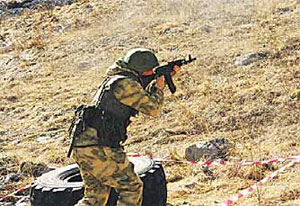
Even after the graduated scout companies return home, the 54th center continues working with them. The officers in Dar’yal say that they continue watching their students through scouting directorates of districts and armies.
“We have a feedback system, if i can put it that way. Experience exchange. Because the Army uses the soldiers we taught in combat and training situations. After a while, when our graduates are completing their tasks with other Army units, we are provided with feedback about their performance, which allows us to change the training program for the better. ”, – Plotnikov concludes.
We should note, that airborne troops train there as well. The airborne scouts are trained to land from helicopters in the mountains in the “assault way”, when they jump out of the moving helicopter at low heights and low speeds; as well as using special lines. Part of the trainees conduct a parachute jump, which is especially important for recently created deep infiltration units of airborne scouting companies, for which a parachute is the main “delivery method” behind enemy lines.
But we cannot forget, that the scouting companies also conduct their missions from APCs and other land vehicles. Which is why Dar’yal is equipped with a driving range, where drivers and commanders learn alpine driving.
“And my loyal mate, the carabiner”
In the individual alpine kit that every soldier has, one can find a securing system, ropes, two carabiners (one big and one small), a device for descending, a device for ascending. Every soldier must have an assist guiding line, for moving on cliff or icy regions”, – the chief of cycle, captain Vadim Arkatov marks.
Of course, comparing this to the equipment of professional mountaineers, is not that much.
“They only carry what is essential for one to cross a mountain area. A scout is not a professional mountaineer, his task is first and foremost to complete a combat mission, not to conquer height. For this, he carries personal weaponry, equipment, munitions, communication devices. Sometimes the weight gets up to 40 kg. They don’t carry things that are not of absolute necessity”, – captain Arkatov clarifies.
According to the instructors and teachers of the 54th center, the individual mountaineering kit allows a person (with appropriate training) to cross rocky, icy cliffs, snowy regions without much trouble.
“When a scout leaves for his mission, he is aleady wearing his rucksack. If he comes across an obstacle, he tooks it out, and puts it on. It is of great importance to have all elements of the mountaineering kit out, unlike in a tourist set, are compatable with military gear, vests, etc”,- Vadim Arkatov says.
The elements, included in the kit, used by the scouts, were designed and approved by the defense ministry at the 90s.
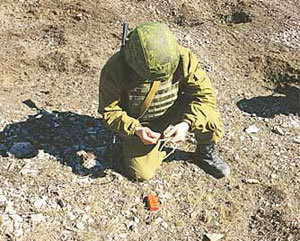
“These are tested, reliable items, that often exceed in quality any civilian analogues. Additionally, if we compare it with more recent developments, our kit could be lighter”, – chief of the cycle marks.
As of last year, the Russian Defence Ministry has accepted new mountaineering harnesses. The first shipments have already arrived in Dar’yal.
The new set has many items from a Russian company “Vento”. They are not only lighter, but also more comfortable. For example, the harnesses have a wider belt and it’s easier to work with it. If before, our carabiners were steel, here they are from an alluminium alloy. New, missing elements from the kit were added as well. ”, – captain Arkatov marks.
Alpine “armoury”
The center pays lots of attention to firearms training, especially in harsh alpine conditions.
“When being on altitude, higher than 2000 meters, you need to consider the atmospheric pressures and the angle of the slope, the target’s on. In other words, consider that the we se the sights to ‘3’. After shooting from 300 meters away, if we haven’t considered the slope of the angle, we will miss. To consider all this, we must provide both theoretical and practical training, – fire arms instructor explains, captain Alexey Vinogradov. – We must also take under consideration the fact that a mountain battle is characterised by shorter distances- aound 150-200 meters ”.
Instructors and teachers of the center aren’t there only to teach the recruits how to work with the Russian Army’s firearms, they also experiment with various sighting systems: “Practical shooting” is also studied.
“First and foremost, this is a sport. Using it as a base, we create special alpine shooting exercises”, – captain Vinogradov says.
The instructors say that in the mountains, where every extra gramm counts, the most optimal decision is to not overload the firearm with various extra tuning bits, but to limit it to a simple collimator sight.
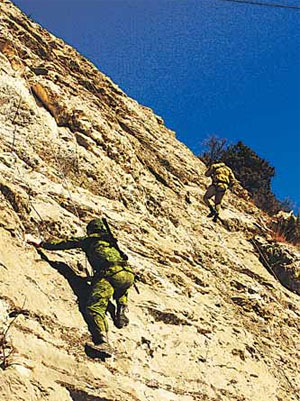 “We find the new night scope 1PN93 very good. We can use it at night and during daytime as an optical sight. In the Ratnik complex there is a collimator sight included as part of standard issue. It’s not that bad, on the contrary of what some people say. In my opinion, if used in the ight way, it’s the same as any western analogue. It holds the shot well, it’s not distrupted with time, sharp picture, good optics. The engineers did a great job”, – the firearms instructor concludes.
“We find the new night scope 1PN93 very good. We can use it at night and during daytime as an optical sight. In the Ratnik complex there is a collimator sight included as part of standard issue. It’s not that bad, on the contrary of what some people say. In my opinion, if used in the ight way, it’s the same as any western analogue. It holds the shot well, it’s not distrupted with time, sharp picture, good optics. The engineers did a great job”, – the firearms instructor concludes.
As it goes for the “Pecheneg” MG, it didn’t get much praises. The weapon is reliable, powerful and easy to work with, but because of it’s weight, walking around in the mountains with it, let alone climbing, is very hard. According to captain Vinogradov, for a MG gunner in the scout detachment, something like M249 SAW would be more helpful, but suited for 7.62 mm calibre.
“The box for this MG must be hard, like “Pecheneg”’s one, but it must have cloth cover for noise cancellation. Currently, the MG gunners are forced to glue their own improvisations onto the boxes, but they don’t live long”, – the captain shares his experience.
Currently, the scouting units are armed with several types of pistols. The old and tested by combat and time PM, which is currently being replaced with Yarygin’s pistol. A few special noiseless pistols built out of Makarov and PSS. According to the interviewed people, the PSS is more preferable, because it sits better in the hand and is well balanced. But the most optimal choice for scout troops is the modified Yarygin’s pistol, it can be equipped with a silencer if needed.
The specialists don’t recommend using different IR lighting systems and lasers in night combat in the mountains.
“We are not alone on the plane, if the enemy is higher and has night vision equipment, a laser and IR lighting will immediately tell them where we are”, – Vinogradov explains.
“They must be removed from the pass”
Currently, in the Russian Armed Forces, lots of attention is being paid not only to the creation of alpine units, but also to their training and equipment.
54th Center of “Dar’yal” is not only a base for army scouts’ training, it is also a first class alpine polygon, used by marines, Spetsnaz units, Naval scouts, etc to train theur own instructors.
Also, in the Prielbrus’e, in the Terskop town, is situated the Ministry of Defense Alpine preparatory center, that has been operating for a few years now. Unlike “Dar’yal”, the program there is aimed at training the soldiers of the basics of mountaineering.
The soldiers that arrive in Terskop study skiing, learn how to work on glaciers, assauly alpine positions, climb to the summits, including Elbrus. Many of those, who graduate, complete their sports instructors’ licences.
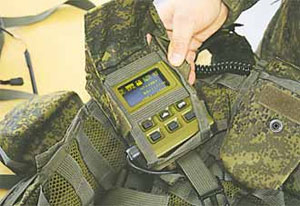
It is worth noticing that the staff of 54th center have to complete a compulsory course in Terskop. According to captain Arkatov, the chief of cycle in “Dar’yal”, the mountaineering instructors’ positions are given only to those, who have at least a second class sports qualification (Russian sportsmanship grading scale). They also must complete the instructors’ school and get the appropriate licence.
Alpine training – is an imprortant element in teaching the soldiers of not only the Special Operations Forces, but also of Spetsnaz units. In every scout battalion, there are spetsnaz units that are officially called “alpine” – who are not only trained, but also equiped to fight at very high altitudes.
It is clear, that climbing to various summits isn’t just dictated by one’s fitness preparation, it also depends on a person’s moral. But which combat (not training) tasks can the Spetsnaz acomplish on high mountain passes, glaciers and summits?
The experience of modern warfare shows that these are the places that are actively used by various terror cells, and also by regular militaries of hostile countries to stealthily infiltrate the territory of a neighbouring country. The Indo-Pakistani War’s experience in Kargil shows that the mountain passes and glaciers are easily becoming battlefields where artillery and aviation is widely used. This is why one of the main tasks of alpine troops – is to secure the passes in a timely manner, control the paths and glaciers. And if the enemy decides to pass through them, there will be trained soldiers waiting for them.
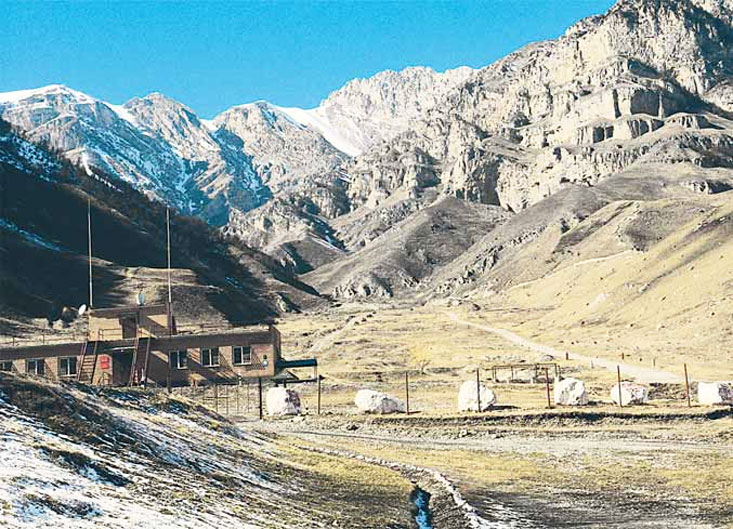
And on the heights below 2500 meters, the combat is very frequent. We can remember a recent recapture of Kesab’s district from pro-Turkish fighters, where the heights vary from 100 to 3000 meters.
From the Turkish side, Kesab is accessible only via one road, but Bashar Asad’s troops secured it in the first days of the Civil War. The fighters, using mountain passes (with great difficulty) could not gather their forces, and failed in supplying the line. Unfortunately, the regular Syrian Army did not have soldiers, who were trained to operate in those conditions to stop the enemy.
In the last years, the Russian Alpine School became, without a doubt, one of the best in the world. “Dar’yal”’s teachers and instructors are already exchanging experience in the Swiss Armed Forces Mountain Service Competence Center. It is notable, that even Western sanctions and Ukrainian conflict didn’t prevent the Swiss government from inviting our instructors to exchange experience with this alpine country’s military.





